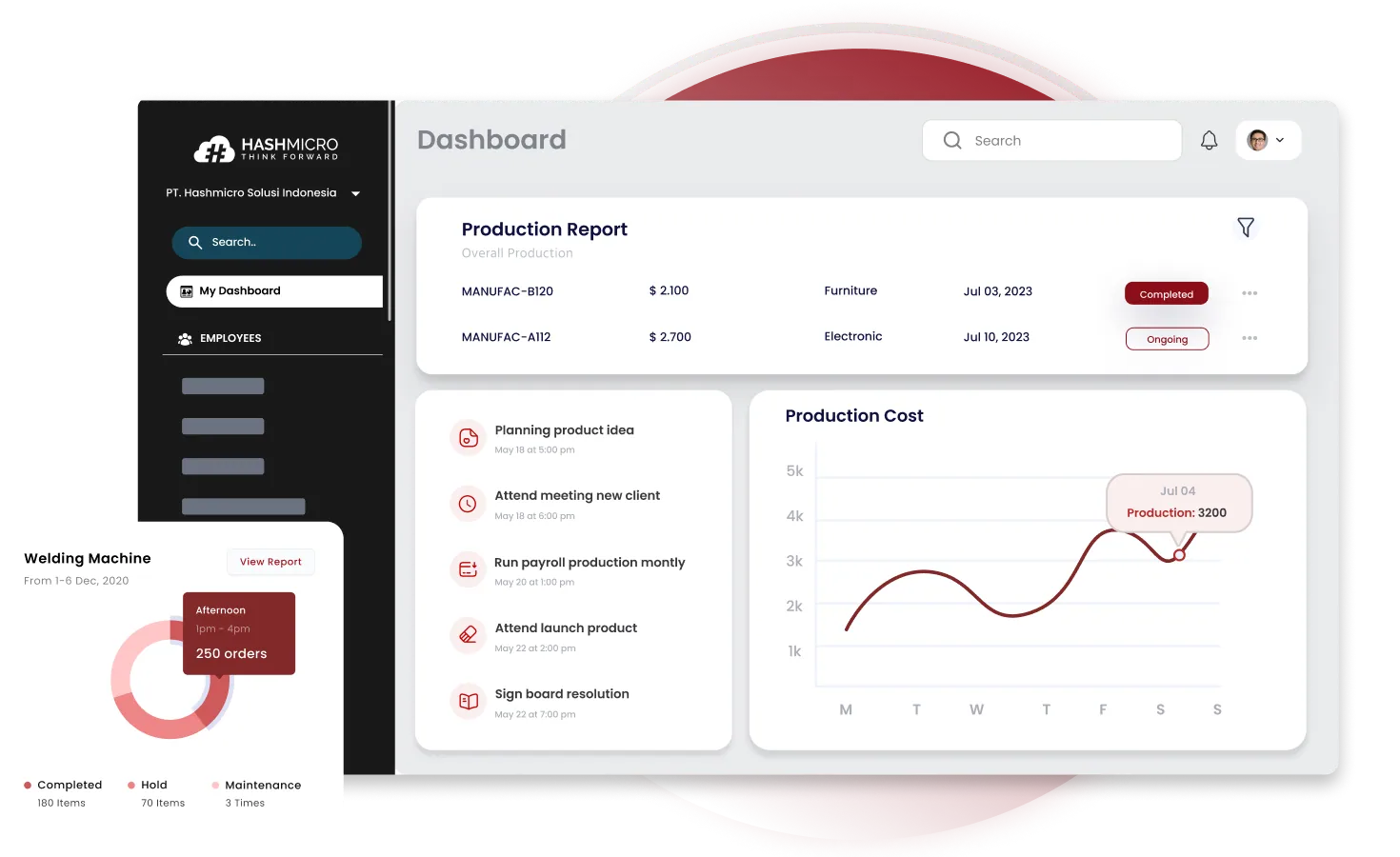Are you letting hidden inefficiencies drain your factory’s productivity? OEE in manufacturing is more than just a measurement; it’s a guide to boosting productivity and cutting waste. By focusing on availability, performance, and quality, OEE in manufacturing helps you find and fix hidden issues to improve operations.
Don’t let hidden issues slow you down—discover how OEE in manufacturing can boost your success! Read on to find simple steps like focusing on key equipment, using IoT, and adding ERP systems to improve production.
Key Takeaways
|
Table of Contents
What is OEE in Manufacturing?
Overall Equipment Effectiveness (OEE) is the global standard for evaluating productivity in manufacturing. This metric allows companies to measure how effectively their equipment runs. By analyzing three core factors: availability, performance, and quality, OEE helps identify inefficiencies within manufacturing processes.
With these insights, companies can save time and materials while improving equipment productivity. OEE is a helpful tool for Filipino manufacturers looking to simplify processes and boost production. This measure supports better decisions and leads to greater productivity and profits in manufacturing.
Core Components of OEE
OEE is built on three key components: availability, performance, and quality, each providing crucial insights into different areas of equipment productivity. Understanding these components is essential for a comprehensive view of manufacturing efficiency.
| Components | Description |
|---|---|
| Availability | Evaluates the impact of both planned and unplanned downtime, showing how much time equipment is actively contributing to production. |
| Performance | Measures how efficiently machines are running compared to their maximum potential, indicating if production speed meets optimal levels. |
| Quality | Tracks the percentage of products produced without defects, ensuring output meets established standards. |
By understanding these elements and implementing asset management software for manufacturing, manufacturers can adapt OEE metrics to their unique production lines, leading to more accurate and effective performance tracking.

Why Calculating OEE in Manufacturing Can Be Challenging
Calculating OEE accurately is challenging because it requires analyzing large amounts of data across three core metrics: availability, performance, and quality. Each of these metrics provides valuable insights into different aspects of equipment productivity, but gathering and verifying this data can be complex and time-consuming.
Setting realistic thresholds for these metrics is also crucial to ensure accurate results. If thresholds are too low, OEE measurements may be misleading, showing an inflated view of equipment performance and hindering productivity goals. Balancing these metrics properly is essential for gaining useful insights.
Why is OEE Important?
OEE is crucial because it gives manufacturers a clear view of their equipment’s effectiveness. By measuring availability, performance, and quality, OEE identifies where machines fall short, whether from downtime, slow speeds, or quality issues.
With OEE insights, manufacturers can address inefficiencies, boosting productivity and profitability. Regular tracking promotes proactive maintenance, better scheduling, and quality control, streamlining operations and increasing output. For competitive companies, OEE is a vital tool for continuous improvement.
7 Strategies to Improve OEE in Manufacturing Plant
To maximize OEE and enhance productivity, manufacturers can implement targeted strategies within their operations. These approaches help address common issues and optimize equipment performance, ultimately driving efficiency.
Here are seven practical strategies to improve OEE:
1. Prioritize Critical Assets
Focusing on key assets that heavily impact your production line ensures that any issues in vital equipment are addressed promptly. By prioritizing these assets, you can prevent bottlenecks that slow down the entire process.
This focus not only supports a steady production flow but also helps maintain product quality and equipment that produces more consistent results.
2. Use a Customized OEE Formula
Adapting the OEE formula to match your business’s specific needs allows for more accurate and relevant insights. For example, if high-quality output is essential, weighting quality more heavily in your formula can provide a better reflection of your goals.
Conversely, if your production focuses on high volumes, prioritizing performance in the OEE calculation can help you monitor speed and efficiency more effectively.
3. Integrate OEE with ERP Systems
Linking OEE with a manufacturing ERP system streamlines data collection, reducing human error and providing real-time insights. With ERP integration, forecasting, inventory, asset tracking, and maintenance scheduling can all be managed more effectively.
This ensures your operation runs smoothly. This integration allows employees to shift focus to higher-value tasks that improve overall productivity.
4. Leverage the Internet of Things (IoT)
IoT devices enhance OEE by providing real-time machine data, allowing for immediate alerts to potential issues. With IoT sensors, you gain valuable insights into equipment performance, enabling a proactive response to maintenance needs.
This helps to prevent unplanned downtime and extends the lifespan of your equipment, leading to more consistent output and reduced costs.
5. Implement Routine Preventive Maintenance
Preventive maintenance is essential to keep equipment in optimal condition, reducing the likelihood of unexpected repairs. By scheduling maintenance based on real-time data, your team can address wear and tear before it leads to downtime.
ERP reminders ensure maintenance schedules are followed, supporting uninterrupted operations and enhancing equipment reliability.
6. Optimize the Plant Environment
The plant environment plays a key role in equipment performance, as factors like dust, temperature, and humidity can negatively affect machinery. Monitoring these conditions allows you to maintain an environment that supports machinery and reduces breakdowns.
This approach minimizes wear on equipment and ensures that production quality remains high over time.
7. Monitor Progress with Regular OEE Analysis
Regularly evaluating OEE helps you track improvements, spot inefficiencies, and make data-driven decisions for ongoing improvement. Frequent analysis allows you to adjust strategies as your production goals evolve.
This ensures that OEE remains aligned with operational targets. The continuous monitoring helps you stay proactive in optimizing your production process for long-term success. Manufacturing inventory software can also help track spare parts availability to support timely maintenance.
Automate OEE Calculating with HashMicro’s Manufacturing Software
HashMicro’s Manufacturing Software provides a comprehensive suite of tools to streamline every part of production management. It simplifies complex scheduling, tracking, and quality management processes. With its intuitive interface, the software makes optimizing each stage of the manufacturing workflow manageable.
Some of its features are:
- Manufacturing Production Scheduling: Allows users to forecast production needs based on historical demand and analyze production graphs for better decision-making.
- OEE Tracking: Offers real-time tracking of equipment effectiveness, helping identify areas for improvement and ensuring machines run at their best.
- Real-Time Stock Input and Output for Production: Provides up-to-the-minute data on stock levels, helping to manage inventory efficiently and avoid production delays.
- Manufacturing Gantt Chart Schedule Management: Visualizes the entire production timeline, making it easy to plan, track progress, and adjust schedules as needed.
By reducing bottlenecks and minimizing downtime, it helps manufacturers use resources more efficiently. A manufacturing software system such as HashMicro’s tools enables enhanced productivity, accuracy in planning, and fast responses to production demands, boosting overall efficiency.
Conclusion
OEE in manufacturing is essential for identifying and addressing inefficiencies in production, helping manufacturers boost productivity and reducing waste. By focusing on availability, performance, and quality, OEE provides valuable insights into where machines may fall short, allowing for targeted improvements.
With HashMicro’s Manufacturing Software, manufacturers can simplify OEE calculations and automate key processes, from scheduling to real-time monitoring. Manufacture software helps address issues more easily and improves overall performance. Try our free demo to see how HashMicro can transform your production efficiency.

FAQ Around OEE in Manufacturing
-
What is OEE manufacturing?
OEE (Overall Equipment Effectiveness) in manufacturing measures how effectively equipment performs in production. It assesses availability, performance, and quality to identify and reduce inefficiencies.
-
What does 85% OEE mean?
An OEE score of 85% indicates high productivity, where equipment meets most production goals. It suggests minimal downtime, optimal speed, and high-quality output, approaching “world-class” standards.
-
What is the difference between OEE and efficiency?
OEE measures equipment effectiveness based on availability, performance, and quality, providing a comprehensive view. Efficiency focuses only on production speed and does not account for quality or downtime.


























